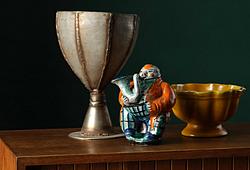Francesco Ubertino Bacciaccia, tillskriven
Maria Magdalena
Pannå 60,5 x 46,5 cm.
Proveniens
Svensk privatsamling,
Bukowski Auktioner, auktion 552, 26-29 maj 2009, kat nr 292. (Såld för 816.000 kr), dennes dödsbo.
Övrig information
Bachiacca, born in Florence, apprenticed in Perugino's Florentine studio, and by 1515 began to collaborate with Andrea del Sarto, Jacopo Pontormo and Francesco Granacci on the decoration of painted furnishings for the bedroom of Pierfrancesco Borgherini and Margherita Acciauoli. In 1523, he again participated with Andrea del Sarto, Franciabigio and Pontormo in the decoration of the antechamber of Giovanni Benintendi. While he established a reputation as a painter of predellas and small cabinet pictures, he eventually expanded his output to include large altarpieces, such as the Beheading of St. John the Baptist, now in Berlin.
In 1540, Bachiacca became an artist at the court of Duke Cosimo I de' Medici and Duchess Eleanor of Toledo. In this capacity, Bachiacca was a colleague and peer of the most important Florentine artists of the age, including Pontormo, Bronzino, Francesco Salviati, Tribolo, Benvenuto Cellini, Baccio Bandinelli, and his in-law Giovanni Battista del Tasso. Bachiacca's first major commission was to paint the walls and ceiling of the duke’s private study with plants, animals and a landscape, which remain an important testimony of Cosimo's interest in botany and the natural sciences. Bachiacca also made cartoons for two series of tapestries, the Grotesque Spalliere (1545–49) and the Months (1550–1553), which were woven by the newly-founded Medici tapestry works. Francesco signed only one known work, the decoration of a Terrace for the duchess and her children, with his abbreviated Christian name and nickname: "FRANC. BACHI. FACI.”.
Bachiacca belonged to a family of at least five, and possibly as many as eight artists. His father Ubertino di Bartolomeo (ca. 1446/7-1505) was a goldsmith, his older brother Bartolomeo d’Ubertino Verdi (aka Baccio 1484-c.1526/9) was a painter, and his younger brother Antonio d’Ubertino Verdi (1499–1572)—who also called himself Bachiacca—was both an embroiderer and painter. Francesco’s son Carlo di Francesco Verdi (-1569) painted and Antonio’s son Bartolomeo d’Antonio Verdi (aka Baccino -1600) worked as an embroiderer. This latter generation probably continued to produce paintings and embroideries after Bachiacca's death and until the Verdi family extinguished about the year 1600.


































